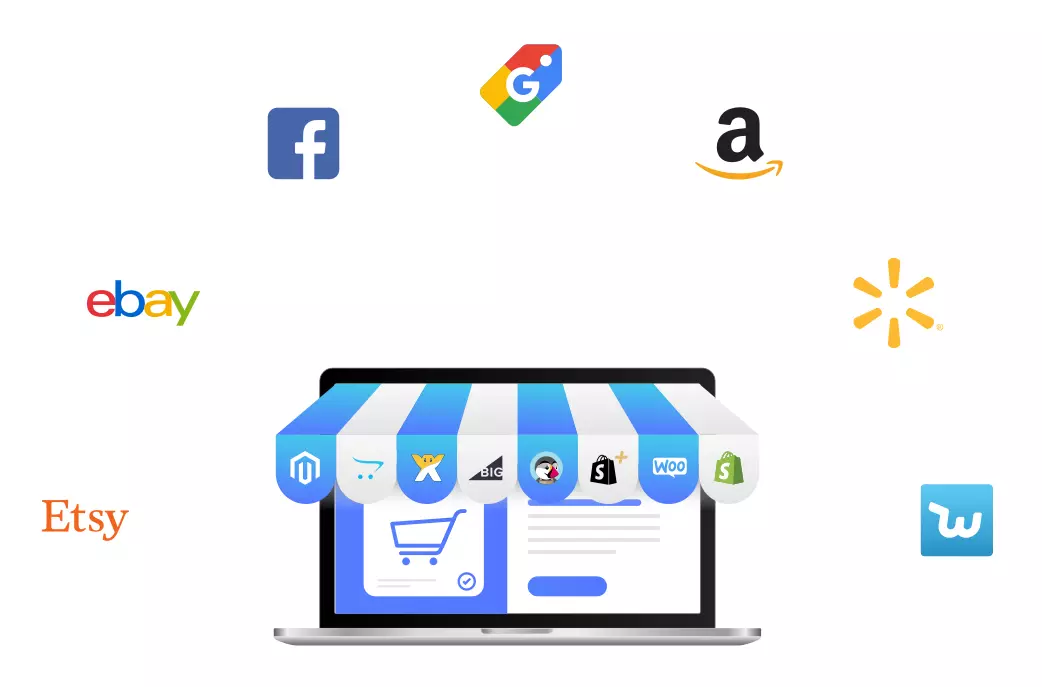What is Multichannel Selling (2024)? Tips to Start
 By Anna10 Apr,2024
By Anna10 Apr,2024Multichannel selling has become a cornerstone of modern e-commerce, enabling businesses to reach more customers and generate additional revenue streams. And customers today expect to interact with businesses across platforms, from browsing an ecommerce website to learning about products through social media videos.
In this article, we'll explore what multichannel selling is, why it's important, its challenges, and how you can use a multichannel software like 4Seller to help implement an effective multichannel approach for your business.1. What is multichannel selling?
Multichannel selling refers to the practice of selling products or services to customers using more than one sales channel, rather than relying solely on a business's website or a single marketplace.These channels may involve making sales in different physical retail spaces, including brick-and-mortar stores and multi-vendor spaces like farmers markets or craft fairs. It can also involve selling through digital channels. These are:
- Online marketplaces like Amazon, eBay, Walmart, Etsy, or Shein
- Website's shopping carts like Shopify, Magento or WooCommerce
- Social ecommerce platforms like TikTok Shop
- Mobile marketplaces like Wish
- Social media platforms like Facebook or Instagram
- Comparison websites like Google
- Each of these sales channel(s) offers their own unique customers, market focus, marketing efforts and benefits (as well as challenges).
2. Why should I be multichannel selling? 4 benefits
In short: to increase sales. Business owners embrace selling on multiple sales channels to enhance brand awareness, reach more customers, deepen existing customer relationships, and increase sales.
- Diversify revenue streams: One of the key advantages of multichannel selling is the ability to diversify revenue streams. If a business relies solely on one platform or channel for sales, they're at risk of losing revenue if that platform goes down or the market changes. By spreading out their sales across multiple channels, businesses can reduce that risk and even tap into new markets and customer segments.
- Expand brand recognition: Another benefit of multichannel selling is enhanced Brand Recognition: By listing products on a variety of platforms, you can easily showcase your brand to potential customers across different platforms. This helps businesses to increase their visibility, expand brand recognition and awareness, and reach a wider audience. This, in turn, can lead to building a strong reputation that can increase sales.
- Boost sales: Customer preferences vary depending upon age, location, and shopping motivations. As a seller, you can build customer trust by meeting people in their favorite sales channel. Multichannel selling can increase sales by giving customers more options to purchase a product at any time, and from any channel that is more convenient and suited to their preferences. A brand that doesn't have a mobile-friendly online store, for example, could miss out on reaching a customer base that predominantly shops on their phones.
- Competitive Advantage: A strong multichannel sales strategy can give you a competitive advantage in the market. By being present on multiple platforms, you can differentiate your brand and products, and gain access to more customers, increasing your chances of success in a competitive marketplace.
- Better Inventory Management: A multichannel sales strategy allows you to optimize inventory management by spreading your products across different channels, reducing the risk of overstocking and out of stock issues.
3. 5 challenges of multichannel selling
Of course, multichannel selling isn't without its challenges.
Let's first quickly preview the 5 challenges
- Account management: Managing accounts across multiple channels can be a real challenge. Each channel has its own interface, policies, requirements, and expectations. Keeping up with all of these things can be overwhelming, and it's easy to make mistakes. Moreover, you might need to create and manage multiple seller accounts, which can add to the complexity.
- Inventory management: By keeping a presence in multiple marketplaces, you make a pledge to deliver products whenever they are ordered. This makes managing inventory across multiple channels a great challenge. Your inventory management strategy and technology must be top-notch to ensure that you have the correct stock levels at the right time and allocate inventory effectively. This will help prevent overselling or overstocking, which can result in lost reputation, sales or money.
- Price management: Pricing is yet another challenge businesses face with multichannel selling. You need to set competitive and profitable prices across every channel. It's essential to avoid pricing discrepancies among channels, as it can lead to customer confusion and mistrust. However, keeping track of and updating pricing across the different channels can be time-consuming and needs an updated pricing management system.
- Reporting: Seeing a complete picture of your business across multiple channels requires robust and sophisticated data analytics tools. These tools must go beyond just tracking sales figures and inventory levels. An efficient reporting solution will help you identify revenue, sales, and customer behavior, allowing you to make informed decisions.
- Managing the customer experience: Finally, maintaining consistent quality customer service across all channels can be tedious. Customers expect prompt and helpful support regardless of the platform they are interacting with. Moreover, when you sell on multiple channels, customers might reach out to you through different channels, which can add to the complexity. Providing uniform and accurate customer support is vital to building your brand and improving customer retention across all channels.
4. How to use 4Seller to make multichannel selling easier and more efficient?
💡 Many of the challenges of multichannel selling can be solved by using a omnichannel management software like 4Seller. 4Seller is a FREE multi-channel ecommerce management software that integrates your website's shopping cart, online marketplaces, social e-commerce platforms, and shipping carriers into one simple and centralized platform.You can connect your Amazon, TikTok Shop, Shopify, eBay, Walmart and more sales channels to one 4Seller account to manage your businesses, including bulk listing tools, order management, inventory management, reporting functionalities, shipping label printing, Amazon Multi-channel Fulfillment (MCF) integration.

Looking ahead to 2024, multichannel selling is likely to become even more important. As new sales channels emerge and technology evolves, businesses that are able to adapt and leverage multiple channels will be best positioned for success. We may also see new tools and softwares that make multichannel selling more accessible and streamlined.
To find out more, sign up and use 4Seller for free upfront. Contact us today if you need any help.
You May Be Interested:
Popular Posts
- 09 Apr,2025
- 08 Apr,2025
Popular Posts
- 09 Apr,2025
- 08 Apr,2025
Back to top





